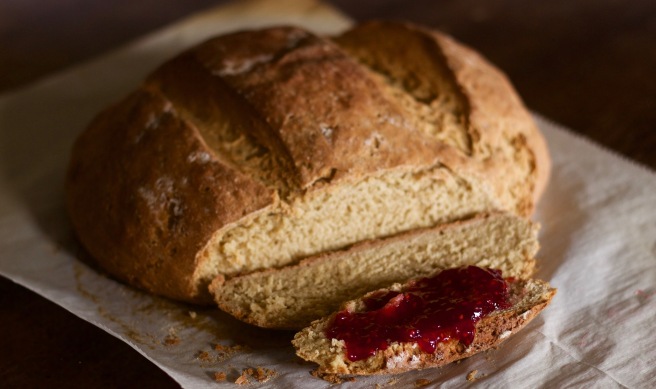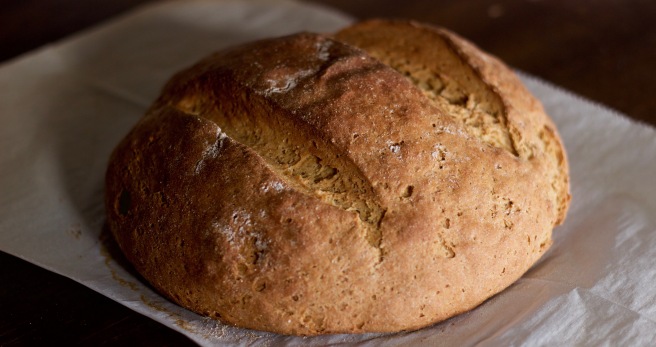
Before going gluten free I didn’t realize how much I relied on wheat. I ate sandwiches and pizza occasionally, but I didn’t consider that wheat thickens béchamel, blankets wontons, and binds granola. Cutting wheat out of your diet doesn’t just change taste, it changes technique. You find new ways to thicken, add chewiness, make things fluffy. After spending the last month dairy free I’ve had a similar revelation.
I had stopped noticing all the ways I consumed milk products: yogurt for breakfast, milk in my tea, a sprinkle of parmesan every time I make pasta—actually a sprinkle of cheese over most meals. Milk and cheese bind sauces, smooth over rough edges. A month of topping tacos with cilantro and eating pasta sprinkled with toasted nuts made me realize how much I used dairy as a flavor crutch. Without it, I tasted other ingredients more clearly.
Wheat and dairy both flavor and structure most of our diets. Get rid of them and you have to find new methods, new tastes. When I began baking gluten free, I was obsessed with finding the perfect replacement for wheat flour, but as I experimented more I realized that the flours I was using could do far more than mimic wheat. They had their own tastes and textures.
Amaranth flour was one of the last ones I experimented with. Early in my explorations, I read on Gluten Free Girl that amaranth had a strong, grassy taste and tended to overpower other flavors, so I stayed away from it. But later on I encountered this article on the benefits of amaranth and I read elsewhere that this tiny grain made bread more tender and extended shelf life—crucial with gluten free baked goods, which seem to go stale almost immediately.
This bread isn’t gluten free, but if you don’t have celiac disease and simply find wheat difficult to digest you may want to give it a try. You can read more about why I eat spelt—and why maybe you can too—here. This boule is high fiber and high protein with a lovely earthy flavor that works beautifully plain, spread with jam, or made into a grilled cheese sandwich.
Please let me know how you like it and tell me about your own favorite alternative flours in the comments.

Amaranth Spelt Bread
1 1/4 cups (300 ml) warm water
2 teaspoons (7 g) dry active yeast
3 tablespoons (45 ml) olive oil
1 tablespoon (15 ml) honey (or maple syrup to make it vegan)
2 cups white (280 ml) spelt flour
1 cup (140 ml) whole grain spelt, plus more for rolling out
1 cup (108 g) amaranth flour
1 1/2 teaspoons (10 g) sea salt
Mix warm water, yeast, olive oil and honey and set aside for 5-10 minutes.Stir in flours to create a shaggy dough.Turn out onto a lightly floured surface and knead for 2 minutes.
Return to bowl, cover with plastic wrap and allow to rise for 45 minutes.
Heat over to 375°.
Turn dough out onto a lightly flour surface and knead for another 2 minutes, until smooth. Shape into a ball and set on a parchment paper lined baking sheet and make 2 shallow slices in the top surface. Cover loosely with plastic wrap and allow to rise until doubled in size, another 30 minutes or so.
Spray surface lightly with water and place in the center of pre-heated oven. Spray inside of oven with more water and bake for 40 minutes.
Cool for 30 minutes before slicing.

Hi! This bread looks amazing! I only have whole spelt flour and whole amaranth flour (and prefer to use only whole grains). Is the white spelt flour essential? Can you make it work with all whole grain flour? What would be the recommended measurements? Could I simply sub out the white spelt for the whole spelt?
LikeLike
Hi Nevena. Thanks for the compliment! Using whole grain spelt flour would probably work but the bread would be much more dense. If you want to try it you could sub 1:1 or you could lighten it up by replacing part of the whole spelt with a starch. Let me know how it goes!
LikeLike